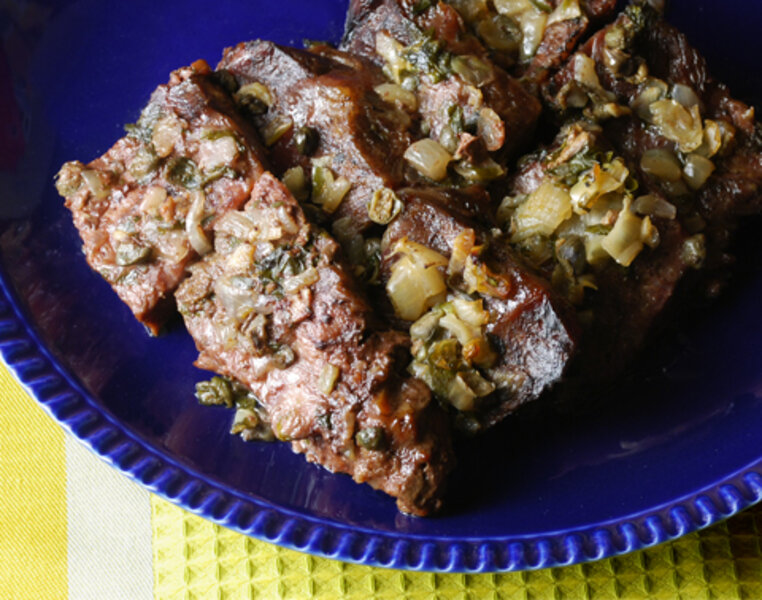Layered pot roast with anchovies, capers, and garlic
Loading...
A couple of weeks ago, I admitted to being a major Francophile when I wrote about roasting chicken on a bed of lentils. I guess that makes Karin over at Second Act in Altadena an enabler. After reading that post, she told me about three different French cookbooks. Already having more cookbooks than we have shelf space for, I immediately headed for the library website and ordered them. Of course, all three showed up within days of each other.
In the interest of fairness, I decided to start with the first book Karin had mentioned – and the first one that turned up at the library, "Backroad Bistros, Farmhouse Fare: A French Country Cookbook," by Jane Sigal. I can see why Karin loves this book. Its nearly 200 recipes are gathered from the French countryside – Sigal toured Normandy, Brittany, Burgundy and Provence to collect not only recipes, but stories about the land, people, shops, restaurants and chefs. And based on my first quick read, the recipes seem fairly straightforward and easy to prepare. There are any number of them I’m interested in trying – this downright simple pot roast from Arles in the South of France seemed like a great place to start.
Though it was founded by the ancient Greeks and expanded into an important city by the Romans, Arles is forever linked in my mind with the Post-Impressionist Vincent van Gogh. He traveled there in 1888, attracted by the rich colors everywhere and by the light – the bright, sunny skies of Provence. Van Gogh spent a little over a year in Arles, producing more than 300 paintings and drawings. Including this one, "Bedroom at Arles," that I visit just about every time we go to the Chicago Art Institute.
The food of Arles is equally colorful. Less than 60 miles from Marseille on the Mediterranean, it is shaped by Greek and Italian influences – as is the cuisine throughout Provence. Tomatoes, garlic, herbs, eggplant, artichokes and almonds are some of the ingredients that show up often in dishes of the region. And bouillabaisse is its rightfully famous classic seafood stew, made with an assortment of fish and shellfish, tomatoes, garlic, saffron, herbs, wine and olive oil.
This layered pot roast incorporates some of the same big flavors – capers, garlic, anchovies – but mellows them with slow cooking. Still, it is so flavorful that no additional salt was required beyond what was in the capers and the anchovies. A quick note for those of you somewhat timid about cooking with anchovies (and I was among your ranks before cooking this dish): They really do melt into the dish, adding a mysterious something to it without taking over. See the Kitchen Notes at the end for more details.
Layered Pot Roast with Anchovies, Capers and Garlic
[Grillades à L’Arlésienne]
Serves 4
Adapted from "Backroad Bistros, Farmhouse Fare: A French Country Cookbook"
1 large onion, finely chopped
2 cloves garlic, finely chopped
2 tablespoons capers, drained and chopped
1/4 cup fresh chopped flat leaf parsley
4 anchovy fillets packed in oil, drained and minced [see Kitchen Notes]
4 tablespoons olive oil, divided
2-pound boneless chuck roast, cut crosswise into 8 slices [see Kitchen Notes]
1. Preheat the oven to 325 degrees F. In a bowl, combine the onion, garlic, capers, parsley and anchovies.
2. Pour 2 tablespoons of the olive oil into a small lidded casserole – large enough to just hold half the meat in a single layer. Arrange 4 slices of the meat in the bottom of the casserole. Top with half of the onion mixture. Arrange the remaining meat slices in a single layer on top of the first and top with the remaining onion mixture. Drizzle the remaining 2 tablespoons of olive oil over the top and cover the casserole with a lid.
3. Place casserole in oven and roast until meat is tender, about 2 hours. [You can also cook this on the stove top, but I think the oven is a better choice – see Kitchen Notes.]
4. At this point, you can serve the dish, but the flavor actually improves if you refrigerate it overnight and reheat it. I popped the cold casserole dish in the oven for half an hour at 325 degrees F. to reheat it while I prepared the sides. [Make sure you use a casserole that can go from the fridge to a hot oven.]
Kitchen Notes
Anything fishy about the anchovies? I’ll answer with a qualified no. The original recipe called for chopping the anchovies, not mincing them. So once or twice, I got a noticeable anchovy note when eating the pot roast. Mincing the anchovies, as I’ve called for in my version, will help them more completely blend in and eliminate this issue. That said, the couple of anchovy-rich bites weren’t onerous, just noticeable. And overall, the mix of big flavors was wonderful – as I said above, I added no salt or pepper to the dish, and they weren’t missed. I’m looking forward to exploring more uses of anchovies in the future.
A chuck roast by any other name. The original recipe called for boneless beef rump. After doing a little research and finding that the flavor and potential toughness issues were similar to chuck roast, I went for the more readily available cut. If you can find a nice thick chuck roast rather than the flatter slabs some stores offer, go for that.
Oven or stove? The original recipe advocated stove top cooking “at a bare simmer,” offering the oven approach as an alternative. Unless you can set your stove’s burner really, really, really low, use the oven. Otherwise, you risk drying out the meat and making it tough.
Related post on Blue Kitchen: Coq au Riesling: the other famous French chicken








